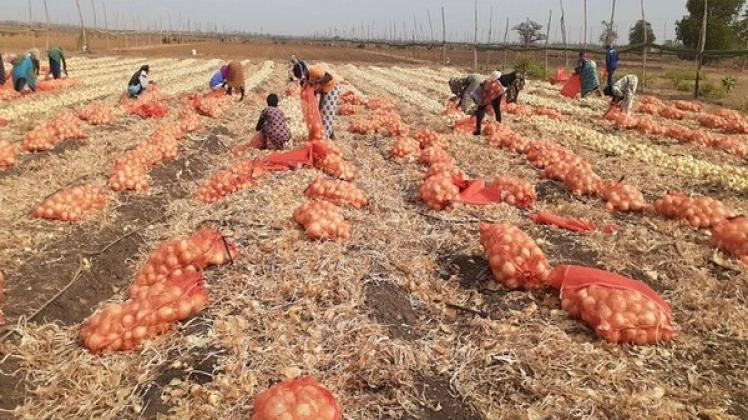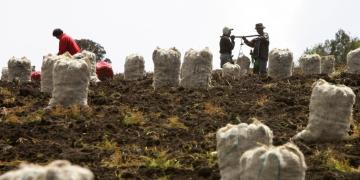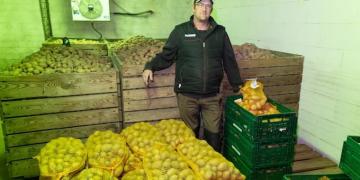Senegal: "Local Senegalese onion cultivation will not yet pose a threat to Dutch exports"
At the Onion Theme Day in Dronten, Marco Groenewold discussed onion cultivation and trade in Senegal. Born in Portugal but raised in the Netherlands, he set up a cultivation company here in 2011 for Van Oers (now Primeale United)

Marco was born in Portugal, but was adopted at a young age by a family in Klazienaveen. "That’s where I caught the farming bug almost immediately," Marco begins. "After my studies, I went back to Portugal to work for a salad company. I lived and worked there with great love for 6 years, until my wife and I became pregnant with our third child and she wanted to return to the Netherlands to be close to family. That’s how I ended up at a vegetable company that supplies European retail. Eventually, my job became to set up a cultivation company in Senegal, with which we could grow and package vegetables all year round for European retail. Initially, this was with green beans, but onions were soon added as an intercrop."
Onion as an intercrop in addition to specializationWhy Senegal? "The advantage of Senegal, and the reason we went there, is that it is located on the west coast, which means you have a boat connection from the country to Europe. Green beans used to come mainly from East Africa, but supermarkets made it increasingly difficult for us to fly in vegetables, which meant we had to look for alternatives. That’s how we ended up in Senegal in terms of climate, from where we can now reach the Netherlands in 8 days by truck and by boat the fastest takes about 7 days. That is a huge logistical advantage compared to East Africa."
"In terms of cultivation areas, you mainly go towards the coast," Marco continues. "The inland is very warm. The further inland you go, the more local growers take over. They irrigate their fields with water from the river, mainly for rice or onions. These growers are already satisfied with 25 to 30 tons per hectare. In terms of quality, they also leave a lot to be desired. They are often grown with nitrogen and a lot of water is pumped into them. Shelf life is therefore not their concern. The onions are harvested, they are put on the side of the road and then a trader comes by and picks them up. He pays and then it is hoped that the grower gets enough money. There are many of these types of growers. We are talking about thousands."
On the coast, the cultivation is mainly done by export companies. "They are specialized in sweetcorn, (water)melons or bottle gourds, but they also grow onions for the local market. We also have 1200 hectares here in various companies, which is mainly intended for export, but about 300 hectares are used for onion cultivation for the local West African market. You have to think of Mali, Guinea, Sierra Leone or Gambia. There is a very large potential here. In addition, there has also been interest in the sweet white onion from Spain for about 2 years, but these are limited volumes."
Like a magnet on a hard driveThe company specializes in green beans, and other companies also have other main activities, but they still decided to also include onion cultivation. "Why? Yes, it wasn’t because we immediately thought it was a hugely lucrative crop, but if you only grow green beans, it’s not good for the land. We wanted to create more rotation. Moreover, we ran into another problem. Green beans are grown from October to April and then the company stood still until we could start again after the rainy season in October. Only, in the months that there was no cultivation, it seemed as if a magnet went through the hard drive of the people there. They lost everything, which meant that we had to explain everything again in October. That took a lot of energy, so we said that we had to do something to keep the people sharp and working. We were advised to go for onions. A very important product in West African cuisine, which is in almost every dish, so we set this up."
"We started this in 2011, but then you have to train people without any education and without any knowledge of Western quality requirements until you have the desired level, so that you can achieve a decent return per hectare. That is perhaps the most challenging." How does it work? "You start by sitting down with a village chief. That can take 5 days or 3 weeks before you reach an agreement, but that is mainly about social matters. What are you going to do for the village? And how many people are you going to give work? Then you make a basic agreement in which you get the land for relatively little money and then you have a piece of bush, which you have to develop. Of course, you check in advance whether there is enough water and then you drill wells. These are located at a depth of approximately 250 meters and then we have a pump room at 130 meters, with which we can pump up 150 to 250 cubic meters per hour."
"You also have to look at electricity. Because where we are, there is no electricity. Or at least not the electricity that can serve these types of pumping stations, so we do everything with diesel generators. We also work with basins to store the water, because sometimes you can suddenly not get diesel for a week, because people in the port go on strike or people in diesel production stop working. You always have to build up buffers everywhere to ensure the continuity of your company."
Remote controlThen of course comes the cultivation itself, in which Marco also experienced the necessary challenges. "You start planting in October. Then you take a fast variety, which needs about 90 days. You harvest this until February. From March 1, it becomes very difficult to achieve a good yield per hectare with the rainy season. Initially, we opted for yellow onion, but West Africans prefer pink, or other red, onions. The more export companies came to Senegal, who started supplying onions, the more picky they became, so we eventually also switched mainly to red onion. These give a yield of about 60 to 70 tons per hectare, where yellow onion gives between 80 and 120 tons."
"Then come the practical problems, where you have to choose between import or local. Machines. We used to get them second-hand from the Netherlands, but nowadays these machines, and especially tractors, are almost impossible to get here, because the diesel quality in Senegal is very poor. Then the machines are quickly finished."
"Another problem was seed. We bought this locally at first, but that was not good. Then you have to consider whether buying locally, which is cheaper, will also help you in the end. The same applies to crop protection products. There is an agency with a head office in Mali, but that does not work. So what you do is that you make a list with the commercial name of the product. Send it to the Ministry of Agriculture. They put a curl under it and you can continue. That is a lot easier here. Of course we try to adhere to the European rules as much as possible, but for product that remains in West Africa, it is all a lot easier."
"Then it’s a matter of training and monitoring the growers properly. I’m there regularly, but not permanently. So you’ll have to do a lot remotely. We do that a lot with photos. We make a square meter per plot, from which they have to report daily what it looks like and what’s in the crop. Always the same place. You may not check this yourself every day, but it’s good to teach them this rhythm and to ensure that they have a passion for what they’re doing," Marco continues. "Eventually it’s harvested. This is still done by hand, because the onions we grow are not genetically strong enough to absorb the blows of mechanical harvesting. Here in the Netherlands we are urged to mechanize everything, but in Senegal this is not always the most economical way to do things."
No danger for Dutch growers/exporters"The onions are pulled out and put in bags of up to about 25.5 kilos. Everything goes in. It doesn’t matter what size. Only the really small ones are left out. And so about 1200 to 1400 women are busy on such a day, after which the men weigh it at a strict 25.5 kilos and load the truck. They then put it in blocks of 1200 bags, which is about 30 tons. These are loaded into the truck and driven to the trader. There it is paid for on the spot and then they can leave again. This is also how the Senegalese traders get through their year. During the import season they trade with Dutch exporters, for example, but in the Senegalese growing season they do it this way with us."
Is this trend of foreign export companies setting up onion cultivation in Senegal a threat to Dutch growers and exporters? "That is certainly not the case for the time being", Marco explains. "The onions we grow go to Mali, Sierra Leone, Guinea, Gambia. That is a huge market with a lot of potential. That population is growing fast and will continue to grow, so there is still a lot to be gained there. Only outside the Senegalese season it is almost impossible to offer local onions. The genetics of the onions used are not yet advanced enough to store the onions well. Moreover, there are no facilities here for that either. We have tried it once, but we also did not succeed in storing them in such a way that we could enter the import season. So there is certainly still a market for Dutch exporters, but in addition we can now make progress with our local cultivation."
Fuente: Agf.nl




